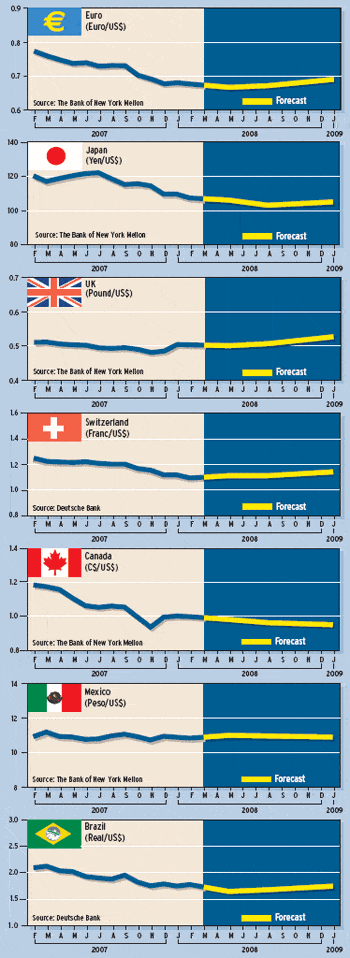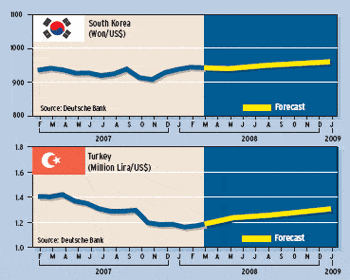Analysts are beginning to watch for signs of a solid bottom for the dollar, following its long-term decline since September 2000. The dollar’s multi-year decline is nearing an end, and the greenback already may have hit bottom against the Canadian dollar and the British pound, says Marc Chandler, global head of currency strategy at Brown Brothers Harriman in New York.
At the same time, market participants are closely watching the actions of the Federal Reserve, and they say the dollar will have a hard time rebounding while US rates are still declining. “We have identified a few factors that we think will help the dollar carve out a low,” Chandler says. “The fact that the market has discounted a hard landing to the US economy, that direct investment flows to the US are increasing, and that the US equity market is outperforming other markets around the world are pieces of a jigsaw puzzle that we think help bring the dollar’s downward trend to a close,” he says.
CURRENCY FORECASTS
 |
FDI flowed into the US to the tune of $414 billion in 2007, an increase of 90% from a year earlier, according to Thomson Financial. The strong inflow appears to have been sustained at the start of 2008, with an additional $22.6 billion in the first two weeks of January.
“The reliance on hot capital, i.e., short-term portfolio flows, to fund the US current account deficit has often been cited as a vulnerability for the dollar,” Chandler says.
“Consequently, the direct investment flows, should they be sustained, seem to be a net positive for the dollar,” Chandler adds.
The currency value of FDI flows is not frequently hedged, even if the income generated from such investments is hedged, according to Chandler.
Another development that could help the dollar trace out a bottom, Chandler says, is that US investors, who have nearly 20% of their equity holdings invested in foreign markets, could begin to shift some of those funds back to the US stock market, which shows some preliminary signs of performing better than overseas markets.
While the US stock market declined in January, the decline in European and Asian markets was even steeper, Chandler says. “And the BRICs, the big emerging markets that have captured so many imaginations, have not been immune to the global equity slide,” he says. Through January 28, Brazil’s Bovespa index was down 8.22% year to date, while Russia’s RTS was off 12.7%, India’s Nifty index was down 13%, and China’s Shanghai Composite had fallen 14% in dollar terms. The US Standard & Poor’s 500 stock index was down 8.4% in the same period.
“One month is a blip for sure, but the outperformance of US stocks appears to be generally true over the last three months as well,” Chandler says, referring to the period from November 2007 through January 2008.
On January 16 the US Treasury released its monthly TICS (Treasury International Capital System) report on cross-border portfolio investment flows and positions between US residents and foreign residents during November 2007. The report indicated that US net long-term portfolio investment eased to $90.9 billion last November from a revised $114 billion in October, but this was still stronger than expected by most market participants.
“The report is positive on two accounts,” says Michael Woolfolk, senior currency strategist at The Bank of New York Mellon. “First, foreign investment has rebounded [from a decline of $70.5 billion in August] and appears adequate to continue funding the monthly US trade deficit. Second, the rebound of investments in dollar-denominated deposits and short-term securities indicates that the ongoing problems in the US credit market and the need for liquidity among foreign investors have begun to improve,” he says.
 |
 |
Overall, the report does not in any way dissuade from expecting a moderate cyclical correction in the US economy in 2008, Wieting says. Exports will help to support the economy this year, albeit at a decelerating pace, he adds.
Meanwhile, analysts say concerns about the Spanish banking system may have helped to put a cap on the euro’s rise. Spanish banks issued a record amount of mortgage securities and asset-backed bonds in the fourth quarter of 2007 and used them as collateral to raise money at favorable rates from the official credit window of the European Central Bank in Frankfurt, according to Moody’s Investors Service.
The rating agency said the total issuance of securities by Spanish banks last year reached about $211 billion, up 55% from 2006. Moody’s said the default rate was likely to increase, with rising concerns among market participants about a sharp downturn in the housing sector.
“The housing market boom that helped lift Spain’s per-capita gross domestic product above Italy’s is now faltering,” says Chandler of Brown Brothers Harriman. Growth in Spain’s economy this year is likely to be closer to 2% than the nearly 3.5% pace seen in 2007, he says.
“By many measures,” adds Chandler, “Spain is steadily losing competitiveness vis-à-vis other countries in the eurozone.”
“Spain’s unit labor costs are rising among the fastest in the region. In part, this is reflected in the deterioration of Spain’s current account surplus, which is nearly 9% of GDP,” Chandler says.
Spanish prime minister José Luis Zapatero has set March 9 for the national election. His Socialist Party will be blamed for the downturn in the economy, Chandler says.



